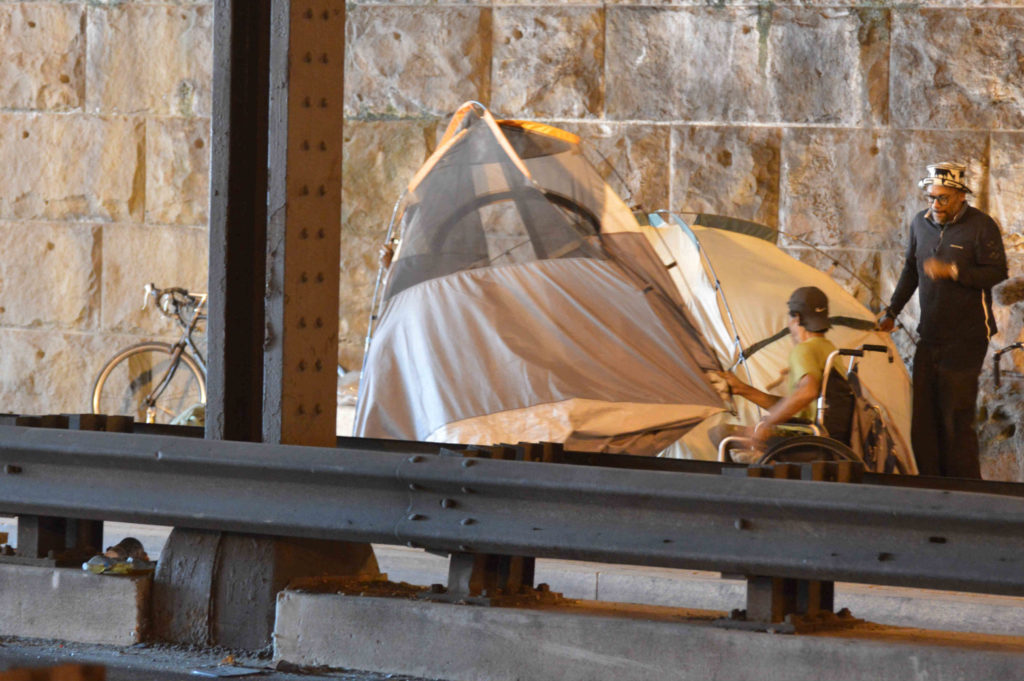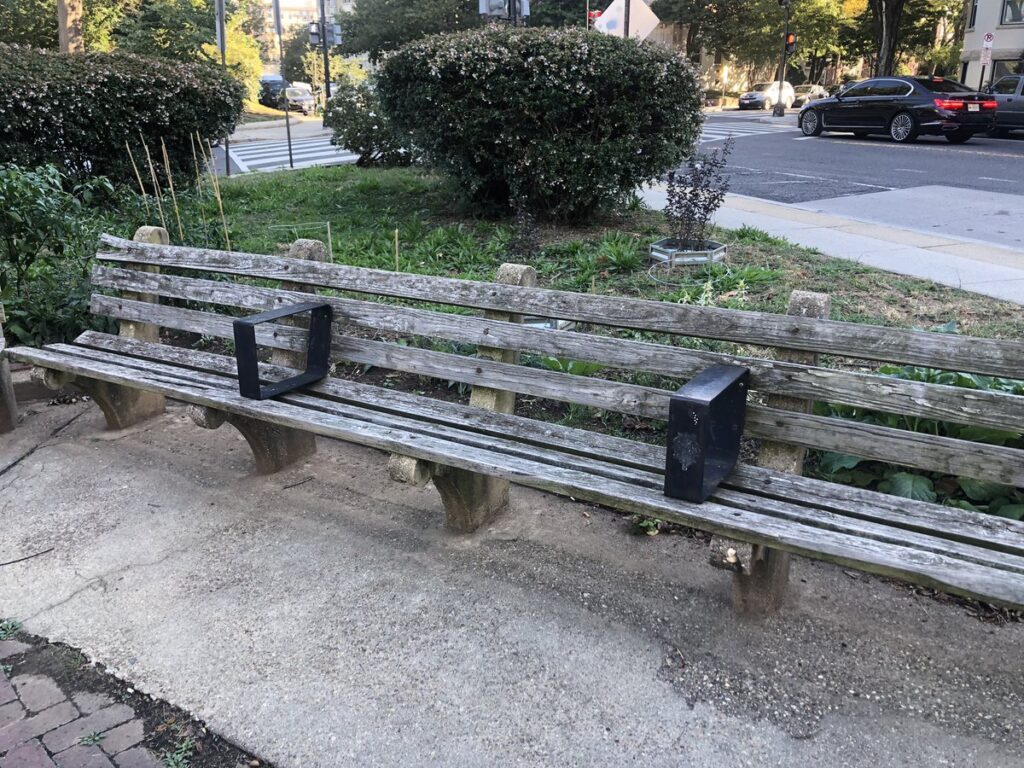In the first two weeks of 2020, residents of the K Street underpass in NoMa were preparing to move permanently. A new city policy, announced through signs posted in the area on Jan. 2, said the sidewalks on both sides of the street had been declared a “pedestrian passageway.” After an encampment cleanup scheduled for Jan. 16 was carried out, all personal belongings left there would be thrown away.
For the past several years, the people living in tents pitched on the sidewalks had always been allowed to move back once the area had been cleaned and city employees had moved on. Nine days before the policy would go into effect, Peace House D.C. published an online fundraiser that promised to help with the move. The collective of activists raised $5,554 in a matter of days.
[Read more: Tents banned from NoMa underpass]
The GoFundMe page was published under the name “Emergency Fund for Homeless Outreach” and organized by Fariha Kay, a co-manager of the Peace House. “Our friends are in dire need of more supplies to help with the move as well as survival during this cold brutal weather,” the page still reads.
Kara Chauncy, 45, has lived in the NoMa encampments for 10 months and knows the frigid weather well. She and her partner burn tissues, hand sanitizer, Vaseline, and baby wipes to help heat their tent during the winter months. Chauncy hadn’t heard anything about the Peace House’s fundraiser and is skeptical of efforts to raise money in the name of the homeless community. “I don’t see advertisements for it, I don’t see any profits or benefits from it, I don’t see anything from it,” she said. “I don’t believe it.”
According to their GoFundMe and Facebook pages, the Peace House used the funds to purchase thermal underwear, tea candles, emergency blankets, food, and other supplies for residents. A Jan. 24 post shows Peace House co-manager Taylor C. Hall playing chess with an encampment resident after delivering supplies. Hall is now listed as the GoFundMe page organizer.

In a press release emailed to Street Sense Media, the Peace House cited a history of similar service. “For four years, Peace House D.C. in coalition with other grassroots organizations and individuals has had the honor of serving the houseless community in D.C. through physical donations, serving meals, and building relationships,” the group wrote. “As the needs of the houseless community have increased this year, we were encouraged to start a GoFundMe to allow others to contribute to the ongoing mutual aid with the houseless community in D.C.”
Former K Street encampment resident Mike Harris disagreed with some items the Peace House chose to provide for him and his neighbors. He claimed to have created a three-page list of items the encampment needs and took particular issue with the small tea candles they delivered. “That’s bogus, man,” Harris said. “Bring out some big three-inch-wide candles, big boys to give off a big flame. Bring us something big and legit like a generator.”
But not all residents agree with Harris’s assessment of their needs. “In the winter, something hot is nice,” said a woman who gave her name as Mamma J and has lived in the nearby L Street encampment since 2012. “A generator is a bit much.”
Encampment resident Aaron Bernier-Garland said he had seen the three-page list and accused Harris of attacking the Peace House’s volunteers. Bernier-Garland is also a Street Sense Media vendor. “[Harris’s] list had crap that we get every day. No one would say that they want another f***ing shaving kit,” Bernier-Garland said. “I have 90 of those in my tent.”
Ami Angell, who volunteered alongside the Peace House to help people move but was not involved with the fundraiser, said that determining what people experiencing homelessness need most is best done on a case-by-case basis. Angell is the founder of the nonprofit The H3 Project. “It’s about listening to the needs of the people instead of assuming we’ve already got the answers,” she said. “Every person is different. One size doesn’t fit all.”
Angell has been doing outreach to homeless people in the District for about three years and said she’s encountered the Peace House multiple times. On Jan. 15, the night before the scheduled cleanup of the encampment, The H3 Project, the Peace House, and other groups such as HIPS gathered to help KStreet residents move. In addition to its mention in the GoFundMe description, this effort was announced at a community meeting held the night before. On the morning of the cleanup, two people still moving items out of the K Street underpass said the Peace House volunteers had been helping them until around 2 a.m. that morning. Bernier-Garland estimated that more than 30 volunteers had shown up. He added that he has probably seen Peace House members serving food and giving supplies to NoMa residents four or five times since moving there in November.
[Read more: City explains new policy and outlines options for encampment residents facing eviction]
“Live from tent encampments. Please listen to what the needs are K street tents being evicted on the 16th, we will help folks move on the 15th. For more information, read the fundraiser,” Kay posted on Facebook on Jan. 7 with this video of Harris giving his initial take on K Street encampment residents’ needs.
The Peace House’s Facebook page shows the group previously held similar crowdfunding campaigns in November of 2018 and May of 2019 to fund their outreach efforts, which include a free store program, community activism workshops, and direct support like their work on K Street. Those raised less than $700 combined and both fell short of the listed goals. In contrast, the January fundraiser surpassed its $5,500 goal on Jan. 19.
Harris accused Kay of creating the GoFundMe when she did to capitalize on attention and concern for the forced move of the K Street encampment residents.
“She established the emergency fund for the homeless for our purpose, that’s what initiated their establishment of the account, and the wording of it itself gave clue to who it was for and what it was going to be used for,” Harris said. “There are a number of encampments in and around Washington, D.C. But there was no encampment that was being shut down and made to move except for us…They could’ve used it for their charitable work, but I think the initial money should’ve been for the residents of K Street because that’s what the fundraiser was started for.”
Angell said the fundraiser was explained to her as an effort to raise money for the group’s year-round outreach, not for any specific community or area. “They posted an update about the encampment cleanup, which lead to the misunderstanding that all of the money was going just to the K Street residents,” Angell said. “I think it was just a miscommunication.”
Bernier-Garland called the fundraiser “a duality strike between funding for the immediate need and for the continued need” and believes the GoFundMe description states its goals clearly. “It was to be as their acts and activism was continuing,” he said. “It covered that it wasn’t simply for today.”
Three out of 10 encampment residents contacted for this story in the two weeks following the implementation of the pedestrian passageway policy on K Street were familiar with the Peace House. Bernier-Garland said that often, people experiencing homelessness do not keep track of the particular groups and people who offer supplies because some distrust their motivations. “I don’t want to know you. You don’t give a f*** about me. You look like you f***ing care, you come in for three seconds so you can rub your own ego and then you leave.”
Meanwhile, the Peace House DC has launched a GoFundMe to raise money & ask people to drop off items, such as thermal underwear, tents, tarps, blankets and candles. https://t.co/fpffOs5XoC
— Chelsea Cirruzzo ???? (@ChelseaCirruzzo) January 10, 2020
“In the four years of our work, we have had an overwhelmingly positive interaction with many houseless communities, and we will continue to collaborate with them,” the Peace House statement read. “We ask that any media specialist or journalist understand our position and respect our decision to utilize the donated funds in a way that benefits the maximum amount of people.”
In addition to the Peace House’s efforts, residents of the NoMa encampments have seen an uptick in support overall since the Jan. 16 move. Chauncy said more people have come through with hand warmers, thermal underwear, chili, snacks, and sandwiches. She hopes to see a larger investment in more expansive long-term support from all the organizations that offer support to people experiencing homelessness.
[Read more: This formerly homeless man is fundraising to provide cold-weather sleeping bags to people on DC streets]
“Nothing like a two thin-layer ham and bread sandwich. I mean, thanks for something. I appreciate the attempt of an effort. But is that something that you would want? That would feed you?” Chauncy said. “If that’s what you’re getting money to do, then save it and use it on something big that would actually do something.”








